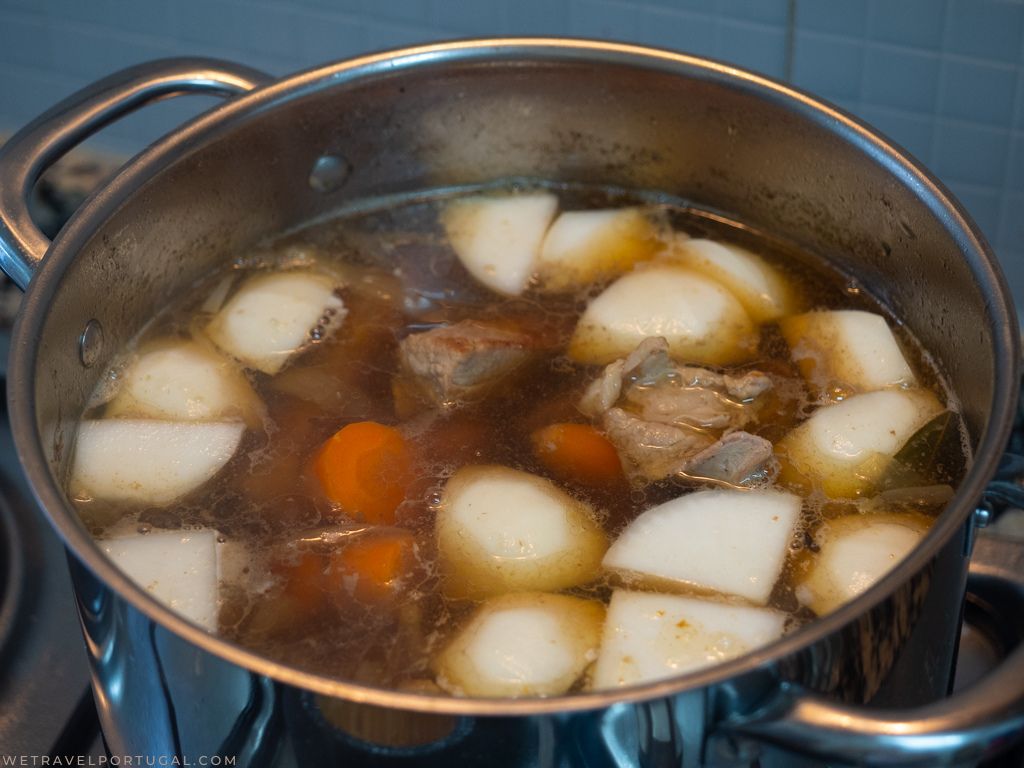Cozido à Portuguesa is a unique dish that combines meat, Portuguese cured meats, and vegetables quite unlike any other cuisine. When we started writing this recipe, we actually struggled to find an international name or translation for teh dish. While some might refer to it as ‘Portuguese Mixed Meat Boil’, others call it simply ‘Portuguese Stew’. That’s because differently to say Custard Tarts and Piri-Piri Chicken, today’s recipe doesn’t seem to be very popular outside of the country. Perhaps because every country has a handful of stews, and a Portuguese Stew might not sound very innovative.
Origins of Cozido à Portuguesa
Cozido à Portuguesa is one of the few Portuguese dishes that is not directly connected to a specific region in Portugal. It’s not too dissimilar to a national dish, and many claim it to be part of the gastronomic patrimony of Portugal. So it’s no surprise that basically every Portuguese restaurant has a version of it on their menu. Although little is known about the origins of the dish, many believe it was borrowed from Spanish cuisine. More specifically, a dish known as olla podrida, that can be translated to ‘powerful pot’.

Similarly, to the Portuguese stew, it combines assorted meats, legumes, and vegetables that are cooked in a rich broth. An olla podrida recipe was published in the 17th century Portuguese cookbook ‘Arte da Cozinha’ by Domingos Rodrigues, which supports this theory that the Portuguese cozido was adapted from the neighbour country. In Portugal, it gained the addition of the local sausages and cured meat like chorizo, alheiras and morcela, gaining popularity as an affordable meal, and a great way to use leftovers, and less noble meats.
Regional Variations of Cozido à Portuguesa
Like most traditional Portuguese dishes, there are dozens of different recipes, and regional variations of cozido. In the north, it typically combines chicken, beef, pig ears and snout, rice and mixed vegetables. In the central region, it’s common to use pork ribs, beans, ham, chorizo, morcela, and farinheira, as well as potatoes, turnips, and Portuguese kale.
In São Miguel (Azores), the stew is called Cozido das Furnas, and the twist is that’s cooked in the heated volcanic soil. Both locals and chefs gather at Furnas at dawn to bury big pots of mixed meat and vegetables. The ingredients are cooked for several hours in geothermal heat, resulting in a rich stew with slightly sulfuric taste, very appreciated by both locals and tourists during the colder months.

Sopa de Cozido – Portuguese Stew Soup
We all know that the Portuguese love a good soup, so from leftovers of cozido, they created another classic, the Portuguese Stew Soup – Sopa de Cozido. It is made simply with the addition of small pasta like macaroni or shells, and more water. We’ll save that recipe for another time though!
Cozido à Portuguesa Recipe
For our recipe of cozido, we took inspiration from the version which is popular in the centre of the country, partially because we prefer the combination of ingredients, and because they are also easier to find and prepare. Our choice of meet is made up of beef, pork ribs, chorizo, bacon, morcela (blood sausage) and farinheira (flour sausage).

As for the vegetables, we used onions, carrots, turnips, and couve lombarda (savoy cabbage). Usually, the stew is prepared by adding the raw meat in a large pot, covering in water, and let it simmer until the meat becomes soft, removing the different meat as they are done, and adding your vegetable based on how long it takes for it to cook. We always like to fry the meat first for extra flavour and colour, but that’s optional and sometimes even unusual in Portuguese cuisine.

Once we add our vegetables, we remove some of the broth and use it to cook white rice to serve it with. Cozido à Portuguesa is a hearty meal which is perfect for the colder months, and days you have more time at hand. We love making it when we have family over, to introduce them to some of our favourite Portuguese flavours. It doesn’t require advanced kitchen skills, nor constantly watching over which is a bonus.
How to Make Portuguese Stew – Cozido à Portuguesa
Cozido à Portuguesa is a hearty meal which is perfect for the colder months, and days you have more time at hand. We love making it when we have family over, to introduce them to some of our favourite Portuguese flavours. It doesn’t require advanced kitchen skills, nor constantly watching over which is a bonus.


Have you tried this recipe? Let us know in the comments!



It’s not stew. We also make stew pretty much like everyone else this isn’t stew and it’s not for everyone
Rude. It is stew. Just because it’s not the kind of stew you are used to.
No, it’s not stew. It’s cozido. It’s more like a soup, in fact, in the Portuguese islands of Azores, people call it “sopas” – which means soups.
This is cooked similarly to a stew however it’s not a stew as ingredients are taken out of the broth and served plated. The broth should however be retained as you can use the leftovers and broth to make a stew or as we refer to it as a soup. Also adding a smoked ham hock or similar adds to the flavor of the broth.
Thanks for the tips Steve, we’ll try it with smoked ham next time!